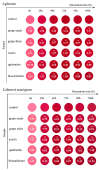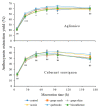Can a Corn-Derived Biosurfactant Improve Colour Traits of Wine? First Insight on Its Application during Winegrape Skin Maceration versus Oenological Tannins
- PMID: 33256051
- PMCID: PMC7760736
- DOI: 10.3390/foods9121747
Can a Corn-Derived Biosurfactant Improve Colour Traits of Wine? First Insight on Its Application during Winegrape Skin Maceration versus Oenological Tannins
Abstract
In winemaking, oenological tannins are used to preserve wine colour by enhancing the antioxidant activity, taking part in copigmentation, and forming polymeric pigments with anthocyanins. As a novel processing aid, in this study, a biosurfactant extract was evaluated as a solubilizing and stabilizing agent of anthocyanins in red wine. The biosurfactant extract under evaluation was obtained from a fermented residual stream of the corn milling industry named corn steep liquor (CSL). Two red winegrape varieties (Vitis vinifera L. cv. Aglianico and Cabernet sauvignon) were studied for anthocyanin content and profile, and colour traits, during simulated skin maceration for 7 days at 25 °C, as well as polymerization and copigmentation at the end of maceration. A model wine solution was used as a control, which was added either with the CSL biosurfactant or with four different oenological tannins (from grape skin, grape seed, quebracho, and acacia). The results showed that CSL biosurfactant addition improved the colour properties of skin extracts by the formation of more stable compounds mainly through copigmentation interactions. These preliminary results highlighted that the effectiveness of CSL biosurfactant is variety-dependent; however, there is no significant protection of individual anthocyanin compounds as observed for delphinidin and petunidin forms using quebracho tannin.
Keywords: anthocyanin composition; biosurfactant; colour properties; copigmentation; exogenous tannins; polymerization; skin maceration; wine grapes.
Conflict of interest statement
The authors declare no conflict of interest. The funders had no role in the design of the study; in the collection, analyses, or interpretation of data; in the writing of the manuscript, or in the decision to publish the results.
Figures



Similar articles
-
Role of anthocyanin traits on the impact of oenological tannins addition in the first stage of red winegrape skin simulated maceration.Food Chem. 2020 Aug 1;320:126633. doi: 10.1016/j.foodchem.2020.126633. Epub 2020 Mar 18. Food Chem. 2020. PMID: 32240924
-
The Effects of Pre-Fermentative Addition of Oenological Tannins on Wine Components and Sensorial Qualities of Red Wine.Molecules. 2016 Oct 31;21(11):1445. doi: 10.3390/molecules21111445. Molecules. 2016. PMID: 27809234 Free PMC article.
-
Grape skin anthocyanin extraction from red varieties during simulated maceration: Influence of grape seeds and pigments adsorption on their surface.Food Chem. 2023 Oct 30;424:136463. doi: 10.1016/j.foodchem.2023.136463. Epub 2023 May 26. Food Chem. 2023. PMID: 37269632
-
From Flavanols Biosynthesis to Wine Tannins: What Place for Grape Seeds?J Agric Food Chem. 2019 Feb 6;67(5):1325-1343. doi: 10.1021/acs.jafc.8b05768. Epub 2019 Jan 24. J Agric Food Chem. 2019. PMID: 30632368 Review.
-
Medical Benefits and Polymer Applications of Grapes.Polymers (Basel). 2025 Mar 12;17(6):750. doi: 10.3390/polym17060750. Polymers (Basel). 2025. PMID: 40292569 Free PMC article. Review.
Cited by
-
Effect of a Multifunctional Biosurfactant Extract Obtained from Corn Steep Liquor on Orange and Apple Juices.Foods. 2022 Nov 4;11(21):3506. doi: 10.3390/foods11213506. Foods. 2022. PMID: 36360119 Free PMC article.
-
Effect of a Biosurfactant Extract Obtained from a Corn Kernel Fermented Stream on the Sensory Colour Properties of Apple and Orange Juices.Foods. 2023 May 11;12(10):1959. doi: 10.3390/foods12101959. Foods. 2023. PMID: 37238776 Free PMC article.
References
-
- Fulcrand H., Dueñas M., Salas E., Cheynier V. Phenolic reactions during winemaking and aging. Am. J. Enol. Vitic. 2006;57:289–297.
-
- González-Neves G., Gil G., Barreiro L. Influence of grape variety on the extraction of anthocyanins during the fermentation on skins. Eur. Food Res. Technol. 2008;226:1349–1355. doi: 10.1007/s00217-007-0664-2. - DOI
-
- Cagnasso E., Rolle L., Caudana A., Garbi V. Relationship between grape phenolic maturity and red wine phenolic composition. Ital. J. Food Sci. 2008;20:365–380.
Grants and funding
LinkOut - more resources
Full Text Sources
Other Literature Sources
Research Materials

